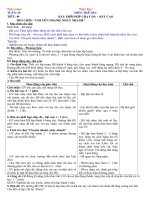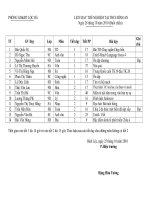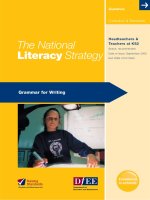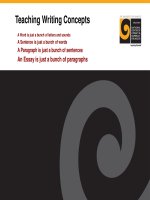The actual sept 28 webinar claire writing (1)
Bạn đang xem bản rút gọn của tài liệu. Xem và tải ngay bản đầy đủ của tài liệu tại đây (522.39 KB, 24 trang )
A Word is just a bunch of letters and sounds
A Sentence is just a bunch of words
A Paragraph is just a bunch of sentences
An Essay is just a bunch of paragraphs
Teaching Writing Concepts
Paragraph Writing Techniques
“It‟s not wise to violate the rules until you know how to observe them.”
T.S Elliot
“When we encounter a natural style, we are astonished and delighted; for we
expected to find an author - and we find a man [woman]!”
Blaise Pascal
By the end of this webinar, you will have increased understanding
of how and why to:
1. Pass on key writing concepts so learners can plan and write paragraphs
anything from short answers in workbooks to longer paragraphs in essays.
2. Teach learners to use a simple „Is-it-a-sentence‟ checklist for each sentence
3. Teach learners to use a simple „Is-it-a-paragraph‟ checklist for each paragraph
Learning Outcomes A
By the end of this webinar you will have basic understanding of how to:
4. Teach how paragraphs are constructed by showing learners that :
• there is one main idea for each paragraph (or two closely linked ideas);
• the focus of the whole paragraph is controlled via the topic sentence;
• a topic sentence is constructed with both a topic and a controlling focus;
5. Build learner confidence and skill by:
1. modelling the paragraph writing process showing thinking, revising and
editing (3 ways to write a paragraph introduced)
• focussing on topic sentence construction initially and then
• providing activities for learners to explore visually how using the same
topic yet a different controlling focus generally leads to totally different
paragraph content.
Learning Outcomes B
Is it a sentence?
Look at the 5 sentences below
For each ask: ‘Is it a sentence?’
1. high school leavers enrol in vocational courses every year
2. Tutors teach writing skills such as note taking and paragraph writing and tutors link
writing skills to course context.
3. Vocational tutors embed writing skills into their course context
4. Students enrol in vocational courses because they see them as practical options.
5. Students enjoy studying and my cat had kittens yesterday.
Sentences
• begin with a capital letter
• end with a full stop
• contain one main point
• can be long or short
tutors link writing skills to course context.
No
No
No
Yes, but
Yes
High
.
.
For each paragraph below ask: ‘Is it a paragraph?’
Is it a paragraph?
1.
A tutor asks students to write answers in their workbooks.
She asks them to write short sentences for each question.
The tutor reminds them that sentences start with a capital letter and end with a full stop.
2.
The Warehouse Distribution tutors know that shift workers are required to write a
short report at the end of each shift. Shift work is challenging and tiring. Tutors ask
their students to write such reports, and also teach them how to write those kinds of
reports. The students learn to use simple report writing frames such as: „Who?
What? How? When? Why?‟
A paragraph is
• a group of sentences joined together
(not a list)
• about the same topic
• indented in many different ways
• short or long
This is a list so not a paragraph
„Shift work is challenging and tiring‟ a different topic so not a paragraph
Suggest deciding whether that topic needs its own paragraph.
If so, Shift work is challenging and tiring may be topic sentence for another paragraph.
3.
Learning how to take good notes is worthwhile as poor notes can lead to problems
later on. If a learner cannot understand their own writing or has not organised their notes
well, they will struggle to retain important information. Taking good notes requires good
listening skills, confidence to check and confirm key information with the tutor and lots of
practice. Good notes make it easier to study for end of year exams; learners are more
likely to pass their course requirements with lower stress levels and higher grades.
A paragraph is
• a group of sentences joined together
• about the same topic
• indented in many different ways
• short or long
Taking good notes requires good listening skills, confidence to check and
confirm key information with the tutor and lots of practice.
Two topics in one paragraph! This is not a paragraph.
Suggest taking the second topic (below) and making a new paragraph.
Learning how to take good notes is worthwhile
Topic
Controlling
focus
Topic
Controlling
focus
4.
Note taking is a valuable skill, and there are note taking strategies that we can all
use. Shortened words, abbreviations and symbols can help you get the information
on to the page faster. Use of mind maps, bullet points and numbered lists are ways
to organise ideas on a page. Some people also like to draw pictures, create flow
charts, or use coloured pens or highlighters to illustrate main points.
A paragraph is
• a group of sentences joined together
• about the same topic
• indented in many different ways
• short or long
5.
Note taking style is personal to the individual. Experimenting with the
different note taking strategies taught in class, and then deciding on a style that
suits will benefit learners in the long term.
Are 4 and 5 paragraphs?
Yes Short or long
Yes Indented in many ways
Note taking is a valuable skill, and there are note taking strategies that we can all
use.
Topic
Controlling
focus (a)
Controlling
focus (b)
The learning progressions set out in this book provide a framework that shows
what adult learners know and can do at successive points as they develop their
expertise in literacy learning. This framework can be used as a guide to
identifying the next steps for adult learners. Each progression covers a particular
aspect of learning.
The progressions can be used in many different adult learning settings. They
describe what is learned in the order that it is usually learned.
The first little pig that went off met a Man with a
bundle of straw, and said to him, "Please, Man, give
me that straw to build me a house"; which the Man
did, and the little Pig built a house with it. Presently
came along a Wolf, and knocked at the door, and
said, "Little Pig, little Pig, let me come in.“
To which the Pig answered, "No, not by the hair of
my chinny chin chin."
"Are we all here?" asked the Doctor, after he had got used to the dim light.
"Yes, I think so," said the duck and started to count them.
"Where's Polynesia?" asked the crocodile. "She isn't here."
"Are you sure?" said the Doctor. "Look again. Polynesia! Polynesia! Where are you?"
"I suppose she escaped," grumbled the crocodile. "Well, that's just like her! Sneaked off into the jungle as soon as her friends got into trouble."
Why on earth is indenting in the list???
• a group of sentences joined together
• about the same topic
• indented in many different ways
• short or long
A great time to learn
about text types and
different formatting
required
and What on earth is indenting?
Indentation determines the distance of the paragraph from either the left or the right
margin. Within the margins, you can increase or decrease the indentation of a
paragraph or group of paragraphs. You can also create a negative indent (also
known as an outdent), which pulls the paragraph out toward the left margin. You
can also create a hanging indent, in which the first line of the paragraph is not
indented, but subsequent lines are.
Page margins
Indentation
/>paragraphs-HP010016528.aspx
Basic Paragraph Structures
A
Topic Sentence - Topic + Controlling Focus
Supporting sentence
Supporting sentence
Supporting sentence
Supporting sentence
Concluding sentence (optional
B
Topic Sentence - Topic + 2 Controlling Foci
closely linked
Supporting sentence to focus a)
Supporting sentence/s
Supporting sentence to focus b)
Supporting sentence/s
Concluding sentence (optional
This resource helps tutors to teach how paragraphs are constructed by
showing learners that:
1. there is one main idea for each paragraph (or two closely linked ideas);
2. the focus of the whole paragraph is controlled via the topic sentence;
3. a topic sentence is constructed with both a topic and a controlling focus;
Topic Sentences: teaching sequence for tutors
How do we teach our learners to start writing a paragraph?
Reduce the learning burden
Is it worth spending time teaching
topic sentence structure
and practising creating topics and
clear controlling focuses? The answer is YES
Topic Sentence - Topic + Controlling Focus
Supporting sentence
Supporting sentence
Supporting sentence
Supporting sentence
Concluding sentence (optional
So shall we try it?
Topic Sentence - Topic/Dogs + Controlling Focus/ needs clarity
Supporting sentence
Supporting sentence
Supporting sentence
Supporting sentence
Concluding sentence (optional
Choosing the easy
topic „dogs‟ reduces
the learning burden
while they are
figuring out skills
around topic and
controlling focus.
Learners transfer
this knowledge to
their own context
later.
So, you ask your learners to think about ‘dogs’
Each learner calls to mind their own version of ‘dog’.
Some are still thinking about the weekend.
How do you bring focus?
Suggestion
Play with the whole idea first
Get your learners happy and comfortable
with topics and controlling focuses
Just have your learners brainstorm as many different
controlling focuses for „dogs‟ as possible.
A great competition!
Dogs can be loyal
Dogs come in many shapes and sizes
Dogs can be dangerous
Dogs make great guide dogs.
Dogs have a highly developed sense of smell.
Dogs are expensive to own.
Dogs are sometimes friendly to cats.
Topic
Controlling
focus
Dogs are sometimes friendly to
cats. This usually happens when
they are pets living in the same
home together. However, an
instinct to care for a cat or kitten
that has been injured or is cold
and needs help can sometimes
surface. There are reports of dogs
keeping cats warm and safe as if
they were one of their own.
Then bring one of the examples to show one way of
writing a paragraph: Question / Answer
Dogs are sometimes friendly to cats.
Ask a question in your mind about the controlling focus
Q: When can this happen?
Just writing the answer brings focus to a paragraph.
Dogs are sometimes friendly to
cats. There was a report of a dog
who already had six puppies of
her own and added two kittens to
her family. They fed from her and
played with the puppies just as if
they were puppies themselves.
Question / Answer
Thinking of the many questions
that can be asked is a great
exercise for learners.
It can be a competition where
learners are thinking of as many
questions as possible in groups.
•What kinds of dogs are more
likely to look after cats?
•What kinds of dogs never look
after cats?
•What kind of dogs will always
chase a cat?
•Does the owner need to
encourage or teach a dog to care
for a cat?
•What story do I know about a
dog who has cared for a cat?
etc
What question has been
answered below?
Another great exercise to get
groups to write a paragraph on
large sheets of paper and other
learners then try to guess what
question has been answered.
Dogs come in many shapes and sizes.
There are huge Great Danes and
medium-sized dogs like spaniels and
some poodles. The very small dogs
are those such as Pekinese or
Chihuahua.
Then bring another of the examples to show another way
of writing a paragraph: Examples
Dogs come in many shapes and sizes
Give three examples of this (without writing „for example‟)
This brings focus to a paragraph.
Dogs have a highly developed sense
of smell. Experiments have been
conducted to show that even if their
toys, food or items of clothing are
locked inside containers, dogs are still
able to smell them and so track them
down. Dogs are able to sniff out drugs
at airports and track lost hikers or
people on the run.
Then bring another of the examples to show another way
of writing a paragraph: Proof
Dogs have a highly developed sense of smell.
Evidence. Ask your learners to: „Prove it!‟
Research-based citations or quotes can later be added to
proof paragraphs.
This brings focus to a paragraph.
Have you increased understanding of how and why to:
1. Pass on key writing concepts so learners can plan and write paragraphs
anything from short answers in workbooks to longer paragraphs in essays.
2. Teach learners to use a simple „Is-it-a-sentence‟ checklist for each sentence
3. Teach learners to use a simple „Is-it-a-paragraph‟ checklist for each paragraph
Summary
Learning Outcomes A
Do you now have basic understanding of how to:
4. Teach how paragraphs are constructed by showing learners that :
• there is one main idea for each paragraph (or two closely linked ideas);
• the focus of the whole paragraph is controlled via the topic sentence;
• a topic sentence is constructed with both a topic and a controlling focus;
5. Build learner confidence and skill by:
1. modelling the paragraph writing process showing thinking, revising and
editing (3 ways to write a paragraph introduced)
• focussing on topic sentence construction initially and then
• providing activities for learners to explore visually how using the same
topic yet a different controlling focus generally leads to totally different
paragraph content.
Summary Learning Outcomes B
A Word is just a bunch of letters and sounds
A Sentence is just a bunch of words
A Paragraph is just a bunch of sentences
An Essay is just a bunch of paragraphs
Thank you for attending this
webinar: Teaching Writing Concepts
You may need to return to the PowerPoint to review some of the ideas
before trialing them with your learners. Please feel free to email me with
any questions or comments









